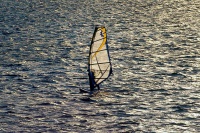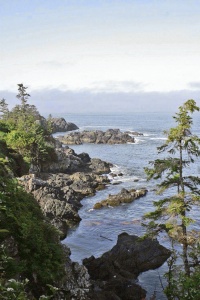
Windsurfing in the 1980s
by Wikimedia Commons
Would you like to try something really funny and entertaining but also physically hard? The next entry from our water sports in Vancouver series is windsurfing. British Columbia is one of the world’s most suitable places for windsurfing. The Vancouver area is one of the most popular places for beginner windsurfers, crawling with professional schools, eager to teach anybody brave enough to stand on the surf and take the sail into her or his hands.
Important People in History of Windsurfing
The history of windsurfing started in 1964, when Newman Derby patented his “free sail system” and successfully advertised it on the technical inventions’ market. In the early sixties, Hoyle Schweitzer, an engineer who happened to be a big fan of windsurfing, and aeronautical engineer and surfer Jim Drake started combining Derby’s “free sail system” with surfboards. They were pioneers followed by many organizations that developed windsurfs as we know them now, complex combinations of design and materials ideal for sailing.
Technique of Windsurfing
 Vancouver Wind by Photodreamz
Vancouver Wind by Photodreamz
Essentially, there are two ways in which you and your board can move across the water. These largely depend on wind conditions. You can either sail, which constitutes moving through the water using (typically) a centreboard and fin or skag for stability and lateral resistance, or hydroplane (or plane), which can be achieved with winds above 10-15 knots, when the board ceases to move through the water and instead planes on top of the water, skimming over the surface at much higher speeds. The ideal conditions for most surfers are at about 15-25 knots.
When sailing, the board is mainly steered by moving the mast either forward or backward. When you’re planing, these controls remain the same, but with much smaller effect. Most of the control is applied by putting pressure on either the left or the right side of the board to engage them, transferring the rider’s mass to the inside of the turn. Here is a video of planing in which you can clearly see the position of the rider.
Necessary Equipment
 Daggerboard by Wikimedia Commons
Daggerboard by Wikimedia Commons
Board
The most useful boards are those that offer a wide range of options for different wind conditions. This means that you’ll be able to ride at wind speeds as low as 12 knots. For this purposes, wider and shorter boards were developed to enhance the planing capability.
Windsurfing boards can be divided into these categories:
- Beginner boards: these tend to be dagger boards, with a lot of volume for better stability.
- Freeride: These boards are usually used in flat waters, well suited for planing at higher speed. Their volume is mostly between 90 and 170 litres. Free sailing is very popular amongst recreational windsurfers since you don’t need to control the course so much at all times or follow a pre-designed path.
- Wave boards: Mostly for breaking waves, these boards are lighter and smaller, with higher manoeuvrability. This type of a board is ideal for you if you’re a bit more advanced (or adventurous) surfer. It’s very suitable for jumping, sharp turning, making cutbacks, and similar crazy stuff. The volume of these boards is between 65 and 90 liters, with a length between 240 and 260 centimeters, and 50 to 60 centimeters in width. The rule for picking the right one is usually that the volume of your board should match your weight.
- Formula Windsurfing Class: Up to one meter in width, for use in Formula Windsurfing races, not as long as other types. If you want to see what formula windsurfing is about, check out this video!
- Slalom boards: These are the boards used mainly for professionals that already know how to maintain manoeuvrability even with such speed-oriented boards.
- Freestyle boards: These boards have similar maneuverability to wave boards, but these are higher volume, wider boards used mostly on flat water. These boards are used for various tricks and jumps since they’re 80 to 110 liters in volume, and about 240 to 250 centimeters in length, usually wider than 60 centimeters.
- Racing longboards: Mistral One Design, or the Olympic RS:X class race boards.
Sail
 Windsurfing by Steve Slaby
Windsurfing by Steve Slaby
Speed
The main feature of these sails is how quickly they’re capable of going in a straight line. To achieve the most wind-friendly design possible, they have cambers installed. These clip onto the mast to lock the shape and maximize the wind-power on the sail. Most of these sails are from 6.0 to 10.0 metres in size.
Freestyle
These sails boast strength, lightness, and great handling all in one. They may have moderate reinforcement to prevent catastrophe if you decide to go after waves. Some versions may even feature a cam or two. Freestyle sails generally vary from 5.5 to 7.5 metres in size.
Wave
These sales have to face the pressure from waves, so they are usually reinforced for the occasions when you get it wrong and they have to struggle on their own. They are very easy to manoeuvre with and jibe. The back of the sale is cut quite high to prevent it from being taken down by the wave. Sizes are generally from 3.5 to 5.5 metres.
The Rest of Equipment
- Harness
- Harness lines
- Joint
- Wet suit/Dry suit
- Footwear
- Helmet
- Personal flotation device
- Fin/Skag
If you wonder how to assemble your windsurf properly, here are some hints that might help you.
The Best Shops in BC
Coastline Surf (map)
Excel-Sports (map)
Airtime Boardsports (map)
Northshore Ski and Board (map)
Compass adventure (map)
Best Places for Windsurfing in BC
 Ucluelet by Docbrakes
Ucluelet by Docbrakes
- Tofino and Ucluelet :
Wickaninnish Beach (advanced to expert)
Long Beach (advanced to expert)
Clayoquot Arm, Kennedy Lake (novice to expert)
- North Island:
Kinman Creek
Bonanza Lake
McCreight Lake
Nimpkish Lake
- Campbell River:
McCreight Lake
Saratoga Beach
Miracle Beach
Salmon Point
Willow Point
- Port Alberni:
Harbour Quay
China Creek
Snow Creek
Sprout Lake Provincial Park
Arden Creek
Polly’s Point
Nitinat Lake
- Nanaimo And Parksville:
Blue Heron Park (intermediate to expert)
San Pereil (beginner to expert)
Rowland Road (beginner to expert)
Transfer Beach (beginner to advanced)
Pipers Lagoon (beginner to expert)
Myron Road (novice to expert)
Eby Road (novice to expert)
- Cowichan Valley:
Maple Grove (beginner to advanced)
Cowichan Bay (beginner to advanced)
Nitinat Lake (beginner to expert)
- Sooke to Port Renfrew:
Jordan River (advance to expert wave sailing, beginner in light winds)
Gordons Beach (beginner to expert)
- Comox Valley:
Goose Spit (beginner to expert)
Saratoga Beach (beginner to expert)
Miracle Beach (beginner to advanced)
Salmon Point (beginner to advanced)
Hornby Island (beginner to expert)
Kye Bay (beginner to advanced)
Alders Beach (novice to expert)
- Victoria:
Willows Beach (beginner to expert)
Island View beach (beginner to expert)
Clover point (advanced to expert)
Cook street (advanced to expert)
Ross bay (novice to expert)
Pat bay (beginner to expert)
Cordova bay (beginner to expert)
Elk Lake (Beginner to intermediate)
For easier orientation when finding these places on the Vancouver Island, check this great map.
Weather
It’s essential to know what the weather will be like when you go windsurfing. You always need to look for two things: the speed and direction of wind and water conditions. Here are a few pages that might help you with this in the Vancouver area.




